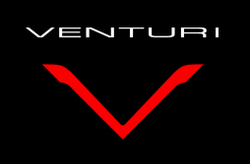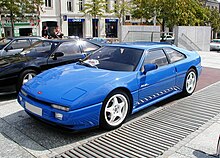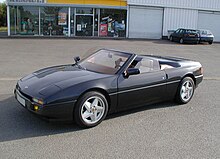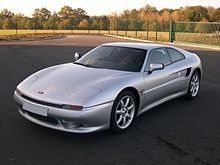Venturi (automobile)
 | |
| Type | Private |
|---|---|
| Industry | Automotive |
| Founded | 1984 |
| Founder | Claude Poiraud Gérard Godfroy |
| Headquarters | |
Key people | Gildo Pallanca Pastor, CEO |
| Owner | Gildo Pallanca Pastor |
| Subsidiaries | Voxan |
| Website | https://www.venturi.com/ |
Venturi is a Monaco-based automotive manufacturer. Founded in 1984 by French engineers Claude Poiraud and Gérard Godfroy as MVS (Manufacture de Voitures de Sport), the company's purpose was to compete in the "Grand Tourisme" market. This was only the most recent post-war attempt at building a sporty luxury car in France, following in the footsteps of Facel Vega, Monica, and Ligier.[1] As with its predecessors, Venturi was immediately faced with many challenges ranging from an unknown name to its under-capitalized and under-staffed state. Venturi did nonetheless manage to continue in production for nearly sixteen years, declaring bankruptcy in 2000. The same year, Monegasque Gildo Pallanca Pastor purchased Venturi, and decided to focus on electric-powered motors. This change of direction led to the limited-production Fétish, the first electric sports car in the world. Following the public's enthusiasm for this first electric model, the brand developed 5 other innovative concept cars.
The first team to commit to the Formula E World Championship, Venturi competes under the name of ROKiT Venturi Racing with its drivers Edoardo Mortara and Norman Nato.
Today, Venturi is specialised in the development of high performance electric vehicles destined to break records or to operate in extreme conditions. Through its Venturi Global Challenges, Venturi aims at demonstrating the efficiency and durability of electric vehicles.
History[]
From 1984 to 2000[]
The first Venturi came out in 1984, created by Claude Poiraud and Gérard Godfroy, two former engineers at Heuliez. The goal was to present the only "Grand Tourisme" French car capable of competing with the English Aston Martin, the Italian Ferrari, and the German Porsche. The first car shown had a Volkswagen Golf GTi engine and the name was originally spelled "Ventury", with a "y" at the end. In 1985, the car was shown with a 200 PS (147 kW) Peugeot 505 Turbo engine, but by the 1986 Paris Motor Show it had reached its definitive form with the PRV V6 engine. Production began in 1987, with five cars built in the first year with production increasing in the subsequent years. The headquarters of the company was located in Couëron, Pays de Loire, where almost 750 cars were produced in the forthcoming 20 years.

From 1987 to the mid-1990s, they built mid-engined coupés and roadsters with turbocharged PRV engines and Renault gearboxes. Engine power ranged from 200 to 260 PS (147 to 191 kW) for the then offered MVS Venturi Coupé and Transcup series. The naturally aspirated Venturi 160 used the catalyzed 2849 cc version of the PRV V6; this was meant to be sold in Japan and was therefore also available with an automatic transmsission. Only a handful were built. There was also the 185 PS (136 kW) Venturi 180, mainly developed for Italy, which used the turbocharged 1995-cc inline-four Douvrin engine from the Renault 21 Turbo.
Venturi was also briefly involved with the Larrousse Formula One team. The team's 1992 car, which bore the Venturi name, was designed and built by Venturi Larousse UK, a British company formerly known as Fomet 1, which had previously designed the 1991 Fondmetal Formula One cars.[2]


The Venturi 400 GT remains one of the highest performing French cars ever produced, and it is in fact the very first car in the world to have standard carbon brakes.[3] True to that claim, the Atlantique 400 GT with a 2,975 cc (3.0 L; 181.5 cu in) DOHC 4 valves per cylinder twin-turbo V6 engine rated at 300 kW (408 PS; 402 hp) at 6000 rpm and 520 N⋅m (384 lb⋅ft) at 4500 rpm of torque with a compression ratio of 7.3:1,[4] delivered excellent performance to put it on par with Ferraris of the early 90s.[citation needed] The 400 GT could hit 100 km/h (62 mph) in 4.7 seconds and 291 km/h (181 mph) top speed, while the Atlantique 300 Biturbo with a 310 PS (306 bhp; 228 kW) V6 could accelerate from 0-100 km/h (62 mph) in 4.7 seconds and could reach a top speed of 275 km/h (171 mph).[5]

A limited-edition 400 GTR was built to satisfy the homologation requirements to compete 24 Hours of Le Mans. High-level competition has also brought fame to the brand. Stéphane Ratel, who would later found the FIA GT Championship, was at the origin of the Venturi Gentlemen Drivers Trophy, which gathered an impressive array of 75 drivers. Venturi has also won fame through its brilliant performances in the 24 Hours of Le Mans, particularly in 1993 with Christophe Dechavanne and Jacques Laffite on Venturi Jaccadi team, and in 1995 with Paul Belmondo racing on the 600 SLM.
However, it was in the BPR Global GT Series races that Venturi established its pedigree defeating Porsche and Ferrari on several occasions. In 1994 in Dijon-Prenois, with Ferté and Neugarten on the 600 LM Jaccadi, at the 1000 km of Paris with Henri Pescarolo and Jean-Claude Basso on the 600 LM, and finally at the 4 Hours Spa race, once again with Michel Ferté and Michel Neugarten.
From 2000 to the present day[]

In 2000, the Monegasque millionaire Gildo Pallanca Pastor bought Venturi and decided to focus on electric-powered engines.[6] This led to the creation of the Fétish model, the first true electric sports car, powered by next-generation lithium-ion batteries. Its design, technology and level of performance left their mark and paved the way for other electric Venturis such as the Volage, an electric concept roadster car with 8 Active Wheel in-wheel motors from French tire giant Michelin, or the America, an electric SUV.
In December 2009, Venturi announced its acquisition of French motorcycle manufacturer Voxan, allowing the firm to enter the motorcycle market.
Venturi Global Challenges[]
Venturi has launched a series of technological and human challenges aimed at demonstrating the reliability and efficiency of electric vehicles in extreme conditions. Through these Global Challenges, the manufacturer is testing the technologies it develops in extraordinary conditions: excessive speeds, extreme weather conditions, difficult terrain in the most remote regions of the planet... As part of these challenges, Venturi has obtained several records and world firsts since 2009.
Mission 01: Jamais contente[]

Mission 01: Jamais Contente is a program launched in 2009 in partnership with the Ohio State University's Center for Automotive Research (CAR). It aims to set electric vehicle speed records on the legendary Bonneville Salt Flats in Utah. The Venturi Buckeye Bullet is the heir to the Jamais Contente, the first ever automobile to break the symbolic 100 km/h mark in 1899. This torpedo-shaped electric car, piloted by Camille Jenatzy, reached 105 km/h, setting a world record for any method of propulsion (steam or petrol)
The VBB-2, a hydrogen fuel cell-powered version, broke the 487 km/h (303 mph) mark in 2009.[7] The following year, the VBB-2.5, an upgraded version with an electric battery pack, achieved an average speed of 495 km/h (307 mph).[8] Finally, in 2016, the VBB-3 – the most advanced electric version of the vehicle with 2,200 kW (3,000 HP) of power – set a new FIA-certified world record of 549 km/h (341 mph)[9] that still stands today.

Mission 02: Shanghai to Paris[]
Mission 02 is an electric car journey reminiscent of Citroën’s Croisière Jaune (Yellow Expedition), one of the first rally raids of the 20th century. Departing from Shanghai on May 3, 2010, the expedition covered 14,900 km, crossing China, Kazakhstan, Russia, Ukraine, Poland, the Czech Republic and Germany, finally arriving in Paris on July 13. To date, this is the longest distance covered by an unassisted electric vehicle. This performance was accomplished by Xavier Chevrin and Géraldine Gabin. The vehicle used was an electric Citroën Berlingo "Powered by Venturi". Only two battery packs were added in order to increase its range to 500 km.
Mission 03: Back To Telegraph Creek[]

Venturi has completed its own zero-emissions version of Citroën’s historic Croisière Blanche expedition (also called the Bedeaux expedition), a 20th-century automobile raid that entailed crossing the Canadian North-West. That historic expedition ended in failure, owing to the nature of the terrain and the disastrous climatic conditions.
On 6 March 2019 in British Columbia (Canada), the Venturi Antarctica travelled 42 km in extreme temperatures as low as -30 °C. The aim of the expedition was to put the machine through a battery of tests in climatic conditions similar to those at the South Pole.[10]
In June 2021, Venturi unveiled the next generation Antarctica which will be deployed at Princess Elisabeth Antarctic research station in December.[11] The vehicle is 3.4 meters long, 2.18 meters high and weighs 2.5 tons. The battery has a capacity of 52.6 kWh allowing an autonomy of 50 kilometers, while the two axial flow motors are capable of developing 60 kW each. Recharging takes from 2 to 18 hours, depending on the context and the weather. With its fold-down bench seat, the vehicle is able to carry up to six people, along with equipment and a second battery to extend the initial range of 50 km.[12]

Mission 04: Kilimanjaro to Okavango[]
Mission 04 is a modern-day version of the “Croisière Noire” (Black Cruise), a 1924 automobile expedition that crossed the African continent from north to south. Mission 04: Africa is the first crossing of Africa in an electric vehicle with complete autonomy. The vehicle has covered 5,800 km, including 600 km of tracks.
Leaving Nairobi, Kenya on 11 May 2012 in a Citroën Berlingo "Powered by Venturi", Xavier Chevrin and Vivien Floris joined Johannesburg, South Africa on 18 June.
Mission 05: Salar de Uyuni[]

The Voxan Wattman set a new world speed record for an electric motorcycle in the 'partially streamlined electric motorcycle over 300 kilos' class. Driven by Max Biaggi, the bike reached 366.94 km/h on the runway of Châteauroux-Centre airport in France. The Wattman holds 11 world speed records:[13]
– ¼ mile, flying start, partially streamlined: 394.45 km/h (245.10 mph) – no previous record
– ¼ mile, flying start, non-streamlined: 357.19 km/h (221.95 mph) – no previous record
– 1 km, flying start, partially streamlined: 386.35 km/h (240.07 mph – previous record: 329.31 km/h (204.62 mph)
– 1 mile, flying start, partially streamlined: 366,94 km/h (228.05 mph) – previous record: 329,09 km/h (204 mph)
– 1 mile, flying start, non-streamlined: 349,38 km/h (217.10 mph) – previous: record 292 km/h (181.44 mph) Max Biaggi on the Voxan Wattman (non-streamlined) – ¼ mile, standing start, non-streamlined: 126.20 km/h (78.42 mph) – no previous record
– ¼ mile, standing start, partially streamlined: 127.30 km/h (79.10 mph) – previous record: 87.16 km/h (54.16 mph)
– 1 km, standing start, non-streamlined: 185.56 km/h (115.30 mph) – no previous record
– 1 km, standing start, partially streamlined: 191.84 km/h (119.20 mph)– previous record: 122.48 km/h (76.11 mph)
– 1 mile, standing start, non-streamlined: 222.82 km/h (138.45 mph) – no previous record
– 1 mile, standing start, partially streamlined: 225.01 km/h (139.81 mph) – no previous record
Motorsport[]
Formula E[]
Venturi was the first manufacturer to join the Formula E world championship. Created in 2013, Venturi has been present on the grid since the championship’s inaugural race in 2014, contesting every E-Prix to date.
In 2015, Venturi became an FIA-approved manufacturer in Formula E, supplying full powertrain systems to Dragon Racing (2015-2016) and Mercedes-backed privateer team HWA Racelab (2018-2019).
In May 2018, the team signed a three-year deal with eleven time Formula One race winner Felipe Massa[14] and rehired seven time Macau World Cup winner Edoardo Mortara as teammate to Massa. Susie Wolff became the team principal in June 2018.[15] At Formula E's landmark 50th race at the 2019 Hong Kong ePrix, Mortara recorded Venturi's maiden victory.[16] Venturi took further podiums at the Mexico City E-Prix and Monaco E-Prix which was also the site of Massa's first podium finish in Formula E. With 88 points, the team took eighth in the championship. Mortara finished 14th in the Drivers’ Standings with 52 points while Massa was 15th with 36 points.
In October 2019, Venturi confirmed that Mortara would again partner Massa while the team entered a powertrain partnership with Mercedes-Benz.[17] On the eve of the 2019-20 season opener, the team announced a three-year Title Partnership with global telecommunications company ROKiT, and also confirmed the retention of Norman Nato as Reserve Driver and the appointment of Arthur Leclerc, brother of Ferrari Formula One driver Charles Leclerc, as Test Driver.[18] Mortara took 14th in the Drivers' Championship with 41 points while Massa was 22nd with 3 points. Venturi finished in 10th in the Teams' Standings with 44 points. At the final race of the season, it was announced that Massa would be retiring from Formula E.[19]
For Formula E's seventh season and first as a World Championship, Venturi re-signed Mortara and promoted Norman Nato to a full-time race seat, with the Frenchman replacing Massa.[20] Jake Hughes, in turn, joined the team as Reserve Driver.[21] Jérôme d'Ambrosio was appointed as Deputy Team Principal after deciding to retire from professional competition at the end of Season 6.
In December 2020, Venturi announced a take over in ownership, with a US investor group led by Scott Swid and Jose M Aznar Botella purchasing the team. Susie Wolff remained as Team Principal and retained an interest in Venturi alongside Founder Gildo Pallanca Pastor.[22]
Complete Formula One results[]
(key) (results in bold indicate pole position)
| Year | Chassis | Engine(s) | Tyres | Drivers | 1 | 2 | 3 | 4 | 5 | 6 | 7 | 8 | 9 | 10 | 11 | 12 | 13 | 14 | 15 | 16 | Points | WCC |
|---|---|---|---|---|---|---|---|---|---|---|---|---|---|---|---|---|---|---|---|---|---|---|
| 1992 | LC92 | Lamborghini 3512 3.5 V12 | G | RSA | MEX | BRA | ESP | SMR | MON | CAN | FRA | GBR | GER | HUN | BEL | ITA | POR | JPN | AUS | 1 | 11th | |
| Ret | 11 | Ret | Ret | Ret | 6 | DSQ | Ret | Ret | 14 | Ret | 18 | Ret | Ret | Ret | Ret | |||||||
| 12 | 12 | 9 | DNQ | Ret | DNPQ | Ret | Ret | Ret | Ret | Ret | 17 | 9 | Ret | 11 | Ret |
List of models[]
- (includes Coupé and Cabriolet versions)1987-1990 – Coupé 160 automatic, Transcup, Transcup automatic (six built)
- 1987-1990 – Coupé 200, Transcup
- 1991 – Coupé 210, Transcup
- 1992 –Coupè 111 Cup[23] (2-liter, four-cylinder export model, mainly for Italy)
- 1989-1996 – Coupé 260, Transcup (sold as the MVS 2.80 in 1989)
- 1991 – 260 Atlantique
- 1994-1996 – 260 LM
- Trophy - 73 built for racing, ten later converted for street use by the factory[3]
- 1994-1997 – 400 GT (15 built, 13 series 1 and two series 2)[3]
- Venturi Atlantique (rework of the MVS Venturi)
- 1996-1998 – Atlantique 300
- 1999-2000 – Atlantique 300 Biturbo
- 1999 – Venturi 300 GTR
- 500 LM - a limited number (~7) were produced and raced at Le Mans, Jarama and Zolder in 1993
- 600 LM - further racing cars were produced later in 1993 with the newer engine[24][25]
- 600 SLM - single example built in 1995, but other cars (originally 600 LM models) have been modified to similar specifications. Appeared at Suzuka, Japan, and Zhuhaï, China.[26]
Electric cars[]
- Fétish, marketed as the first electric sports car in the world
- 'Heritage', 2006[27]
- Eclectic, marketed as the first autonomous urban vehicle in the world
- Astrolab, marketed as the first electric-solar hybrid vehicle in the world
- [28][29] (electric concept roadster car with 8 Active Wheel in-wheel motors from French tire giant Michelin) [30]
- Eclectic 2.0, a more compact of the Eclectic
- Venturi Buckeye Bullet
- Fétish II, the next generation of the Fétish
- , electric crossoverVenturi America
References[]
- ^ Decker, Jean-Paul (July 2014). "Requiem pour un nom" [Requiem for a name]. Rétroviseur (in French). Fontainebleau, France: Éditions LVA (302): 70. ISSN 0992-5007.
- ^ Henry, Alan (1992). Autocourse: the World's Leading Grand Prix Annual 1992-93. Motorbooks Intl. p. 83. ISBN 0-905138-96-1.
- ^ Jump up to: a b c Liszewski, Nicolas (2004-12-23). "Guide d'achat: Venturi 400-GT" [Buyers' Guide] (in French). l'Automobile Sportive. Retrieved 7 March 2018.
- ^ NIck D, ed. (December 20, 2015). "1995 Venturi 400GT". supercars.net. Retrieved June 18, 2018.
- ^ Sébastien Dupuis (ed.). "VENTURI ATLANTIQUE-300 (1996 - 2000)". automobile-sportive.com (in French). Retrieved June 18, 2018.
- ^ "Venturi Automobiles: Monaco-based Automotive Manufacturer". July 2017.
- ^ "FIA records lists" (PDF).
- ^ Barry, Keith (2010-08-26). "Buckeye Bullet Sets EV Land-Speed Record". Wired. ISSN 1059-1028. Retrieved 2020-04-08.
- ^ "Venturi resets electric vehicle world speed record at 341 mph". New Atlas. 2016-09-22. Retrieved 2020-04-08.
- ^ "Successful tests at Auron for Venturi Extreme Vehicle". Monaco Tribune. 2019-02-10. Retrieved 2021-06-22.
- ^ "This Polar Exploration Vehicle Is All-Electric". MotorTrend. 2021-06-17. Retrieved 2021-06-22.
- ^ "Venturi Antarctica: the first zero emissions polar exploration vehicle - automobilsport.com". www.automobilsport.com. Retrieved 2021-06-22.
- ^ "Voxan Wattman electric motorcycle sets 11 new world speed records". Inceptive Mind. 2020-11-05. Retrieved 2021-06-22.
- ^ "Venturi announces Massa for season five". www.e-racing.net. Retrieved 2021-06-23.
- ^ "Ex-Williams F1 tester Susie Wolff becomes Venturi FE team principal". www.autosport.com. Retrieved 2021-06-23.
- ^ Ben Church. "Edoardo Mortara wins controversial Hong Kong E Prix". CNN. Retrieved 2021-06-23.
- ^ "New Beginnings for Venturi in Season 6 | ROKiT Venturi Racing". www.venturiracing.com. Retrieved 2021-06-23.
- ^ "Venturi retains Norman Nato and Arthur Leclerc as test/reserve drivers". Motorsport Week. 2019-11-20. Retrieved 2021-06-23.
- ^ "Felipe Massa in shock split with Venturi Formula E team". www.motorsport.com. Retrieved 2021-06-23.
- ^ "Nato to replace ex-F1 driver Massa at Venturi for 2020-21 Formula E season". www.autosport.com. Retrieved 2021-06-23.
- ^ "Jake Hughes lands Venturi Formula E reserve driver role". www.autosport.com. Retrieved 2021-06-23.
- ^ "Venturi Formula E team under new majority ownership". The Race. 2020-12-09. Retrieved 2021-06-23.
- ^ Andrea. "Venturi 111 Cup, l'auto fantasma". AMblog (in Italian). Retrieved 2020-01-06.
- ^ 1993 Venturi 600 LM at supercars.net, accessed 29 March 2018
- ^ Abishek Dwaraknath, 4 July 2017 venture lm600 supercar lemans country at columnm.com, accessed 29 March 2018
- ^ Photos of Venturi 600 SLM at racingsportscars.com, accessed 29 March 2018
- ^ Mike Spinelli 15 March 2006 Venturi Heritage GT3 Car Completes Test Drive at jalopnik.com, accessed 29 March 2018
- ^ "Paris Motor Show 2008". Venturi.fr. Archived from the original on December 21, 2008. Retrieved 2009-04-29.
- ^ Wojdyla, Ben, (2008-10-03). Venturi Volage Concept Debuts At Paris Auto Show, Sets Standard For Electric Car Wackiness. Retrieved 2008-10-03.
- ^ Rubens, Craig (2008-10-08). "9 Sexiest Electric Cars from the Paris Auto Show". Earth2tech.com. Retrieved 2009-04-29.
External links[]
Officials[]
- Sports car manufacturers
- Car manufacturers of Monaco
- Vehicle manufacturing companies established in 1984
- Solar car racing
- Electric vehicle manufacturers of Monaco
- Brands of Monaco
- Privately held companies
- Luxury motor vehicle manufacturers
- Car brands

